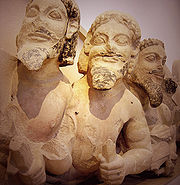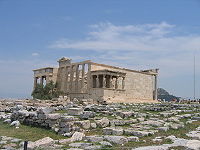
Old Temple of Athena
Encyclopedia

Greek temple
Greek temples were structures built to house deity statues within Greek sanctuaries in Greek paganism. The temples themselves did usually not directly serve a cult purpose, since the sacrifices and rituals dedicated to the respective deity took place outside them...
located on the Acropolis of Athens
Acropolis of Athens
The Acropolis of Athens or Citadel of Athens is the best known acropolis in the world. Although there are many other acropoleis in Greece, the significance of the Acropolis of Athens is such that it is commonly known as The Acropolis without qualification...
. Until its destruction by the Persians in 480 BC, it was the shrine of Athena Polias, the patron deity of the city of Athens. It was located at the centre of the Acropolis plateau, probably on the remains of a Mycenaean
Helladic period
Helladic is a modern archaeological term meant to identify a sequence of periods characterizing the culture of mainland ancient Greece during the Bronze Age. The term is commonly used in archaeology and art history...
palace. Apart from its in-situ foundations, numerous architectural members in the Doric order
Doric order
The Doric order was one of the three orders or organizational systems of ancient Greek or classical architecture; the other two canonical orders were the Ionic and the Corinthian.-History:...
belonging to its different construction phases have been found. The complex is sometimes described by the name "Dörpfeld foundations", after the archaeologist who first studied it.
The foundations suggest the following basic description: The temple measured 21.3 by 43.15 m, on a west-east orientation. It was surrounded by a peristasis
Peristasis
Peristasis may refer to:*Peristasis *Peristasis, inactive phases of vasoconstriction in inflammation...
of 6 by 12 columns. The difference between column axes was 4.04 m, narrowed by 0.31 m at the corners. The stylobate
Stylobate
In classical Greek architecture, a stylobate is the top step of the crepidoma, the stepped platform on which colonnades of temple columns are placed...
was slightly curved, whether this also applied to the superstructure remains unclear. In the pronaos and opisthodomus, two columns each stood between short anta
Anta
An anta is an architectural term describing the posts or pillars on either side of a doorway or entrance of a Greek temple - the slightly projecting piers which terminate the walls of the naos.In contrast to pillars, they are directly connected with the walls of a temple...
e. The cella
Cella
A cella or naos , is the inner chamber of a temple in classical architecture, or a shop facing the street in domestic Roman architecture...
was very short, in fact nearly square, and subdivided in three aisles by two rows of three columns each. The back of the temple was subdivided into a wide rectangular opisthodomus followed by a pair of side-by-side rooms. The foundations were composed of various materials and constructed in varying techniques. While the load-bearing parts and internal supports were made of blue Acropolis limestone, the foundations of the surrounding peristasis were of poros limestone. The superstructure and decorative pieces also appear to have been made from a variety of materials, including 'poros' and Parian marble
Parian marble
Parian marble is a fine-grained semitranslucent pure-white and entirely flawless marble quarried during the classical era on the Greek island of Paros in the Aegean Sea.It was highly prized by ancient Greeks for making sculptures...
.
Because of those variations, the reconstruction of the temple's architectural history remains controversial. Wilhelm Dörpfeld
Wilhelm Dörpfeld
Wilhelm Dörpfeld was a German architect and archaeologist, the pioneer of stratigraphic excavation and precise graphical documentation of archaeological projects...
, assumed that the original structure was a double temple in antis, dating to about 570 BC, lengthened and broadened by the addition of the peristasis under Peisistratus
Peisistratus
Peisistratos or Peisistratus or Pisistratus may refer to:*Peisistratos of Athens, tyrant at various times between 561 and 528 BC*Pisistratus the younger, r...
, between 529 and 520 BC. This idea led to a subdivision of the foundations into an inner smaller structure known as H-Architektur and assumed to be the oldest part of the building, followed by a structure still described as the "Old Temple of Athena", inccorporating the H-Architektur as well as the peristasis.

Sima (architecture)
In classical architecture, a sima is the upturned edge of a roof which acts as a gutter. Sima comes from the Greek simos, meaning bent upwards.- Form :...
s of Parian marble, and capitals as well as a geison
Geison
Geison is an architectural term of relevance particularly to ancient Greek and Roman buildings, as well as archaeological publications of the same...
depicting flying birds, of poros. Further elements likely to be attributable to the early structure because of their size and style include metope
Metope (architecture)
In classical architecture, a metope is a rectangular architectural element that fills the space between two triglyphs in a Doric frieze, which is a decorative band of alternating triglyphs and metopes above the architrave of a building of the Doric order...
s of Parian marble, monumental poros pediments depicting fighting lions, and ion the corners on the east side Herakles on the left and the "triple-bodied" figure on the right. A group of very squat and broad capitals
Capital (architecture)
In architecture the capital forms the topmost member of a column . It mediates between the column and the load thrusting down upon it, broadening the area of the column's supporting surface...
with wide echinus
Echinus
Echinus may refer to:* Mallotus , synonym for a genus of the plant* Echinus , a genus of animals* Echinus , a window manager* Molding , similar to the ovolo molding...
are also ascribed to the early structure, suggesting that it had a hexastyle peristasis.
The Old Temple of Athena as a separate structure is often dated to circa 510/500 BC. Its dimensions are identified as those of the entirety of the foundations excavated by Dörpfeld. Features ascribed to it include: entablature
Entablature
An entablature refers to the superstructure of moldings and bands which lie horizontally above columns, resting on their capitals. Entablatures are major elements of classical architecture, and are commonly divided into the architrave , the frieze ,...
and sima
Sima (architecture)
In classical architecture, a sima is the upturned edge of a roof which acts as a gutter. Sima comes from the Greek simos, meaning bent upwards.- Form :...
of Parian marble, poros capitals with a steeper echinus, a marble frieze
Frieze
thumb|267px|Frieze of the [[Tower of the Winds]], AthensIn architecture the frieze is the wide central section part of an entablature and may be plain in the Ionic or Doric order, or decorated with bas-reliefs. Even when neither columns nor pilasters are expressed, on an astylar wall it lies upon...
depicting a procession, and marble waterspouts
Gargoyle
In architecture, a gargoyle is a carved stone grotesque, usually made of granite, with a spout designed to convey water from a roof and away from the side of a building thereby preventing rainwater from running down masonry walls and eroding the mortar between...
in each of the four corners, shaped as lions' and rams' heads. The pedimental sculptures, now free-standing for the first time, depicted a gigantomachy
Gigantomachy
In Greek mythology, Gigantomachy was the symbolic struggle between the cosmic order of the Olympians led by Zeus and the nether forces of Chaos led by the giant Alcyoneus...
in the east and a scene of lions killing a bull in the west. Of the gigantomachy, parts of the figures of Athena
Athena
In Greek mythology, Athena, Athenê, or Athene , also referred to as Pallas Athena/Athene , is the goddess of wisdom, courage, inspiration, civilization, warfare, strength, strategy, the arts, crafts, justice, and skill. Minerva, Athena's Roman incarnation, embodies similar attributes. Athena is...
, of Zeus
Zeus
In the ancient Greek religion, Zeus was the "Father of Gods and men" who ruled the Olympians of Mount Olympus as a father ruled the family. He was the god of sky and thunder in Greek mythology. His Roman counterpart is Jupiter and his Etruscan counterpart is Tinia.Zeus was the child of Cronus...
, and of a falling enemy are preserved.
The temple, which contained the ancient xoanon
Xoanon
A xoanon was an Archaic wooden cult image of Ancient Greece. Classical Greeks associated such cult objects, whether aniconic or effigy, with the legendary Daedalus. Many such cult images were preserved into historical times, though none have survived to the modern day, except where their image...
or wooden statue of Athena, believed to have fallen from the sky, was destroyed in the Persian sack of 480 BC. It remains controversial whether a partial restoration followed this. Herodotus
Herodotus
Herodotus was an ancient Greek historian who was born in Halicarnassus, Caria and lived in the 5th century BC . He has been called the "Father of History", and was the first historian known to collect his materials systematically, test their accuracy to a certain extent and arrange them in a...
mentions a west-facing megaron
Megaron
The megaron is the great hall of the Grecian palace complexes. It was a rectangular hall, fronted by an open, two-columned porch, and a more or less central, open hearth vented though an oculus in the roof above it and surrounded by four columns. It is the architectural predecessor of the...
on the Acropolis. This reference, as well as a structure listed in an inscription have been interpreted as evidence that the opisthodomus of the Old Temple remained in place through the fifth century. Xenophon
Xenophon
Xenophon , son of Gryllus, of the deme Erchia of Athens, also known as Xenophon of Athens, was a Greek historian, soldier, mercenary, philosopher and a contemporary and admirer of Socrates...
, states that the Old Temple of Athena burned down in 406/405 BC, but this might also refer to the Erechtheion, which had taken over the functions of the Old Temple and housed the xoanon. From the 4th century BC onwards, there are no possible references to the Old Temple; Pausanias
Pausanias (geographer)
Pausanias was a Greek traveler and geographer of the 2nd century AD, who lived in the times of Hadrian, Antoninus Pius and Marcus Aurelius. He is famous for his Description of Greece , a lengthy work that describes ancient Greece from firsthand observations, and is a crucial link between classical...
was not aware of its existence.
External links
- Old Temple of Athena, Planetware.com
- The Great Doric Temple of Athena in "Athen Temples" at The Museum of the Goddess Athena.

